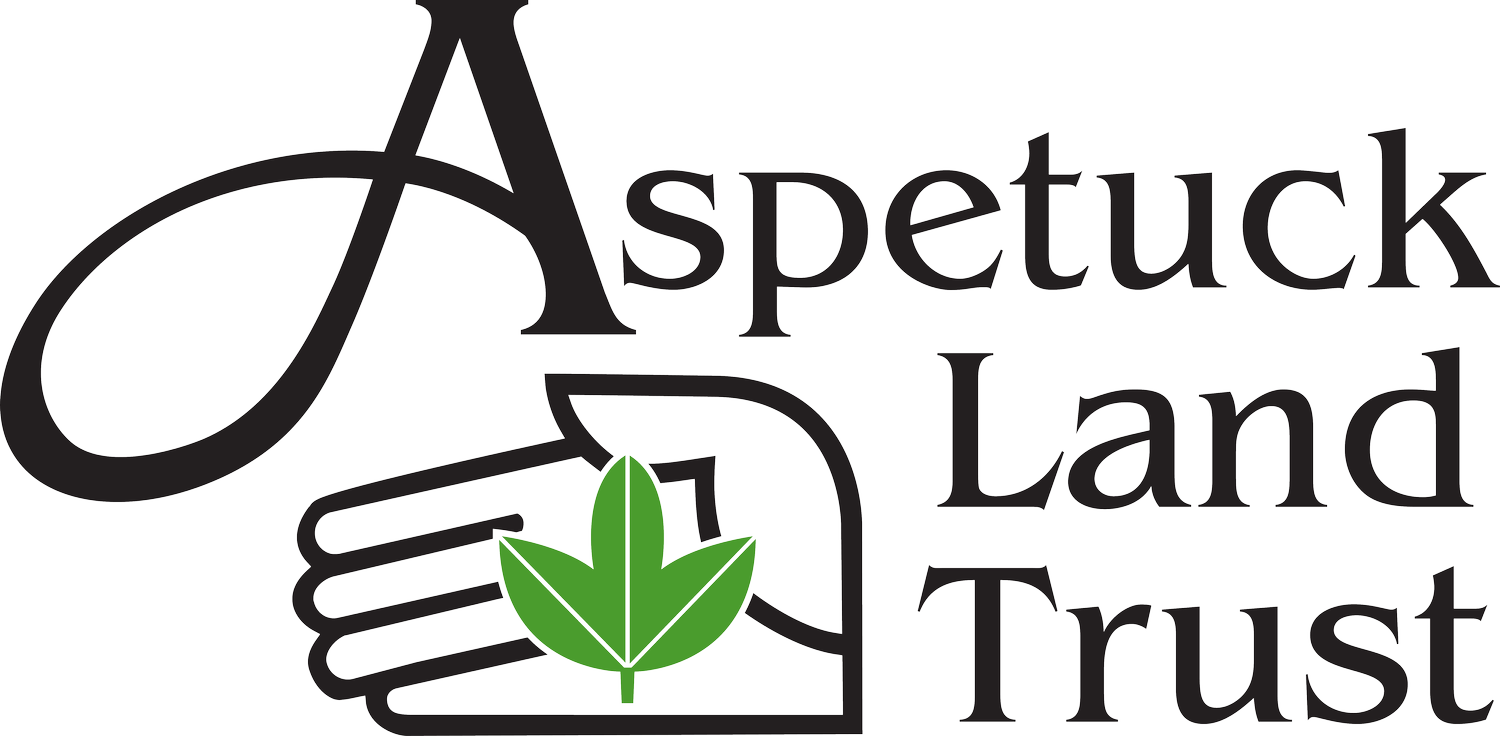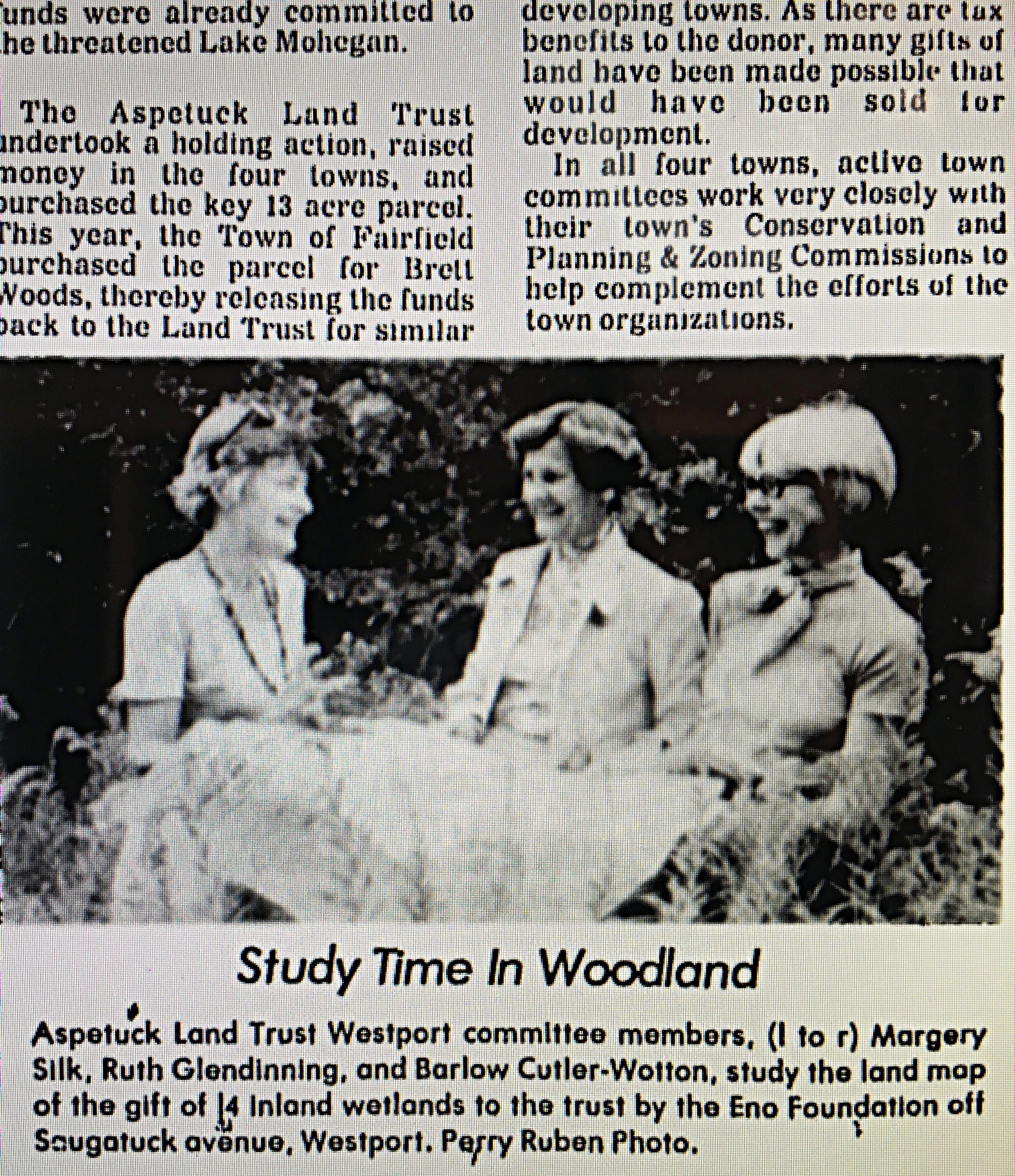History of the Land Trust
Aspetuck Land Trust was one of the first land trusts formed in Connecticut. Currently, Connecticut’s network of over 100 land trusts — nearly one per town — is operating in Connecticut. As a regional land trust in SW Connecticut, we are keenly aware of our region's unique resources and are strongly committed to preserving them.
The Beginning - 1963
By the early 1960’s, pressures on the towns of lower Fairfield County to develop their open parcels of land were mounting. Towns were preparing detailed proposals and guidelines that were intended to guide the Planning and Zoning Commission with their decisions. But gaps in the guidelines were showing up. For example, there was no legal protection of the tidal marshes along Connecticut’s shores and rivers, and inland wetlands were thought of as boggy areas to be filled to make level building sites.
Mrs. Barlow Cutler-Wotton was the president of the Westport League of Women Voters at the time. Attendance at the Planning and Zoning Commission meetings was part of the Observer Corps of the League. She was concerned that an application had just been filed to construct a geriatric hospital on the corner of Wilton Road and Kings Highway North. The extensive salt marsh in this area was part of the application.
Upon hearing Mrs. Wotton’s concern, the Chairman of Planning and Zoning directed her to the lawyer whom he felt would be the most knowledgeable: Leonard A. Schine. It was at their first meeting that Mrs. Wotton learned a most valuable lesson: to separate the desire to save the salt marsh from development from the actual gathering of data that would build a case for the Planning and Zoning Commission. With no tidal wetlands act in place (that would not come until 1969) traffic and congestion at the corner became the cornerstone of the case.
Mrs. Wotton successfully worked to save the salt marsh and in 1987, the salt marsh was given to the Aspetuck Land Trust by the new owners. Named the Taylortown Salt Marsh, with a view down river, it is now an integral part of Westport's open space.
Taylortown Salt Marsh
(Kings Hwy North and Wilton Road)
At the end of her League presidency in 1965, Mrs. Wotton ran for the Representative Town Meeting (RTM) to represent District 2. Supported by her research and urging, in 1966, Westport established a Conservation Commission. Mrs. Wotton and William Turner, both future presidents of the Aspetuck Land Trust, served on this committee.
In those days, land trusts were just being formed around the state in order to support and cooperate with the Conservation and Planning and Zoning Commissions of their towns.
On August 7, 1966, Mrs. Wotton called a meeting in her studio to form a steering committee. Its mission: to set up a land trust for the towns of Westport and Weston, for the purpose of acquiring by gift or purchase lands to be preserved in their natural state as open space. (Westport News, August 11, 1966)
Certificate of Incorporation — October 1966
The scope of the Land Trust was expanded to include the four towns that the Aspetuck River traversed: Easton, Fairfield, Weston, and Westport — thus the name, Aspetuck Land Trust.
First Organization Meeting: October 1966
Aspetuck Land Trust was formally organized at its first board meeting at the home of John Ripley Forbes. Elected as President was Mrs. Wotton; Vice President, John Ripley Forbes; Secretary, Mrs. David R. Williams; and Treasurer, Joseph Fahey, Jr., the Senior Vice President of State National Bank.
Other members of the Board of Directors were Miss Madeline Moses and Miss Katharine Ordway of Weston, Leonard A. Schine, Harry W. Thompson, Joseph J. Thorndike, and William Turner of Westport. Members to represent Easton and Fairfield joined at a later date.
“The purpose of the Aspetuck Land Trust is to promote, for the benefit of the general public, the preservation of natural resources — rivers, streams, tidal marshlands, inland wetlands (swamps, marshes, bogs), woodlands, ridge tops, rock ledges, stands of trees, other natural features and the plant and animal life thereon and the preservation of unique historic and scenic sites.” Westport News, November 3, 1966
“At long last we have a private group that will be able to move quickly to save the fast disappearing rural beauty of our countryside,” said Mrs. Wotton.
First Gift of Land: October 1967
The first land gift of 20 acres was the Twin Bridges Nature Preserve, now called the Leonard Schine Preserve,
given by Ralph Glendinning, president of Glendinning Companies. The headline in the local newspaper appeared only two weeks after the announcement of the organization meeting of the Land Trust: “Glendinning Pledges Gift of 25-Acre Open Space to Aspetuck Land Trust” (Town Crier, November 17, 1966.) A year later on October 5, 1967, the Town Crier also carried the headline, “Aspetuck Trust Gets First Gift of Twenty Acres.” In an accompanying photo, a smiling Ralph Glendinning is handing the deed to a beaming Mrs. Wotton, while John Ripley Forbes, VP of the Trust, looks on.
First Public Meeting: March 1967
Aspetuck Land Trust held its first public meeting on March 31, inviting the public to attend and hear Richard Pough, chairman of the Open Space Action Committee, speak on “The Individual’s Role in Preserving the Beauty of Our Communities.” This meeting was the Land Trust’s first membership drive. As a result of this meeting, two future donors learned of the Trust and decided to donate their land: Miss Eva LeGallienne (the LeGallienne Bird Sanctuary) and Miss Alice DeLamar-LeGallienne (the Stonebridge Waterfowl Preserve.)
IRS Non-Profit Status: 1967
The Land Trust received its this very vital classification as a non-profit corporation in the Spring of 1967. Subsequently, the Board of Directors voted to raise funds to buy the Lobdell property (now named Brett Woods) in Fairfield. From those initial fundraising efforts, the Aspetuck Land Trust endowment was formed.
Monroe Land Trust and Tree Conservancy Merger: 2021
Aspetuck Land Trust (ALT) is announced a merger with the Monroe Land Trust and Tree Conservancy (MLT) effective July 1, 2021.
With the merger, ALT extends its land conservation work from its original four town focus (Easton, Weston, Fairfield and Westport) to five towns. The addition of Monroe brings an additional 20 acres of conserved land in Monroe under ALT’s overall watch and protection.
Key Property Acquisition Dates:
1967 Leonard Schine (formally Twin Bridges), Westport (20 acres)
1968 Honey Hill, Weston (38 acres)
1969 Stonebridge, Weston (21 acres)
1969 LeGallienne, Weston (12.5 acres)
1975 Harwood, Fairfield (15 acres)
1975 Taylor Woods, Weston (17 acres)
1988 Hillman, Fairfield (11 acres)
1992 Putnam & Rudkin, Fairfield (16 acres)
1993 Poindexter, Easton (40 acres)
1994 Crow Hill, Easton (162 acres)
1997 Jump Hill, Easton (117 acres)
1999 Trout Brook Valley, Easton/Weston (730 acres)
2002 Haskins, Westport (16 acres)
2011 Newman Poses, Westport (39 acres)
2012 Randall's Farm, Easton (34 acres)
2017 Belknap, Weston (38 acres)
2020 Gilbertie’s Farm, Easton (34 acres)
2021 Fromson Strassler, Weston (85-acres)
2022 Guinea Rd, Monroe (8 acres)





